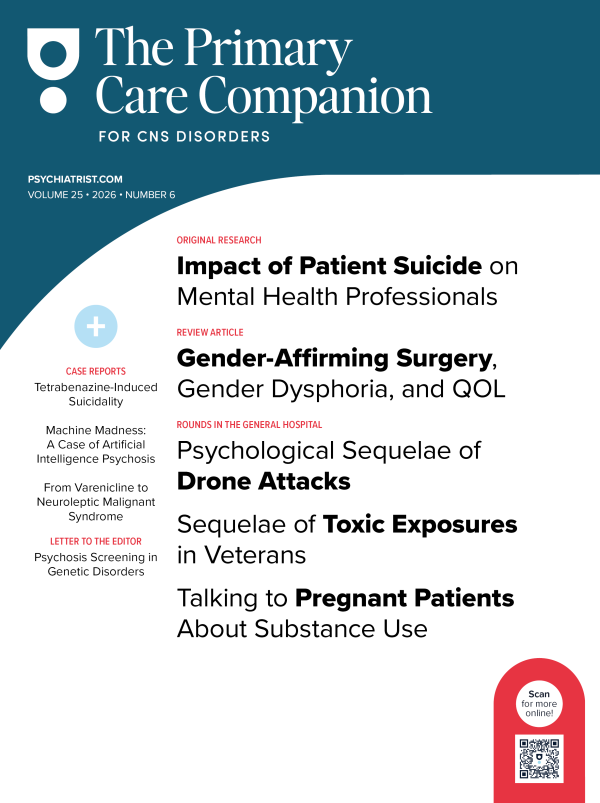Because this piece does not have an abstract, we have provided for your benefit the first 3 sentences of the full text.
To the Editor: Major depression that occurs during pregnancy affects a woman’s judgment in making decisions related to the pregnancy and the fetus, including the decision about whether to continue a pregnancy. The psychiatrist should balance respect for the autonomy of the depressed woman with beneficence-based obligations to the pregnant woman and also to the fetus, when the fetus is viable. Coverdale et al have discussed the clinical implications of respect for autonomy in the psychiatric treatment of pregnant patients with depression and have recommended strategies for assessing decision-making abilities and for enhancing their autonomy.
Assisted Decision Making Using Direct Counseling in a Pregnant Woman With Major Depressive Disorder
To the Editor: Major depression that occurs during pregnancy affects a woman’s judgment in making decisions related to the pregnancy and the fetus, including the decision about whether to continue a pregnancy. The psychiatrist should balance respect for the autonomy of the depressed woman with beneficence-based obligations to the pregnant woman and also to the fetus, when the fetus is viable.1 Coverdale et al2 have discussed the clinical implications of respect for autonomy in the psychiatric treatment of pregnant patients with depression and have recommended strategies for assessing decision-making abilities and for enhancing their autonomy. They suggest that nondirective counseling be used when the fetus is pre-viable and that directive counseling is ethically justifiable when the fetus is viable. Nondirective counseling means discussing various alternatives for the outcome of the pregnancy but not recommending any of them in particular. In contrast, directive counseling recommends management based on either maternal or fetal indications. Here, I present the use of directive counseling to assist decision making in a pregnant woman with major depression.
Case report. Ms A, a 27-year-old woman, was orphaned as an infant. She was admitted to a general hospital in Taiwan because of recurrent suicidal attempts by jumping from height and hanging. The Beck Suicidal Intent Scale3 revealed "high intent" in assessing the severity of her suicide attempt. Diagnostic interview revealed a major depressive disorder, recurrent episode (DSM-IV-TR). Little was known about her day-to-day life. She was unable to work and received disability benefits. Further examination revealed that she was pregnant at 26 weeks. Ms A had variable autonomy to deliver the fetus because the pregnancy was a result of sexual assault and concern about her ability to parent. When asked who helps her make tough decisions, she replied "no one." Since artificial abortion was forbidden after 24 weeks’ gestational age (GA) in Taiwan, the psychiatrist asked the Medical Ethics Committee (MEC) for advice.
The MEC called a meeting with the departments of psychiatry, pediatrics, obstetrics, and social work to help devise a strategy to respect both the patient’s reproductive freedom and the life of the fetus. It was decided that Ms A should be given an antidepressant to help improve her autonomy. After reviewing the antidepressants used in her previous major depressive episodes, duloxetine was found to have been well-tolerated and shown better response than other antidepressants. It also had minimal abnormal outcomes on the fetus.4 Duloxetine was then chosen to treat this major depressive episode. The MEC met with Ms A 3 weeks later and provided directive counseling for her. The MEC invited her to consider her previous and current values regarding the pregnancy and motherhood. She was then assisted in making a decision, based on her values, that she continue the pregnancy to term and place the baby into the adoption process. After a 6-week hospital admission, Ms A gave premature birth to a healthy baby that was 38.5 cm (15.2 in) long and weighed 1,740 g (3.8 lb; G1P1, GA 32 weeks). While recovering from depression, Ms A’s free-will decision was confirmed by two psychiatrists, and a public notary from the District Court began the adoption process.
The treatment of depression during pregnancy poses serious ethical challenges to the clinician. Health care providers have to be sensitive to the issues of autonomy, the levels of which may vary.1 In this case, Ms A was recommended a trial with an antidepressant, which may have helped improve her autonomy within a time frame that would allow her to attend to, absorb, retain, and recall relevant information provided by the MEC. In this case, the fetus, because it was viable, was considered a patient independent of Ms A’s autonomy.2 When the fetus is a patient, both Ms A and the MEC have beneficence-based obligations to the fetus. The baby was 2 months premature and was placed for adoption smoothly.
In pregnancy, the possible risks of medication to mother and fetus, including toxic effects, should be cautiously balanced with the likely benefits.1,2 There was an analysis5 of pregnancy outcome data regarding duloxetine captured in the Lilly Safety System and the US Food and Drug Administration’s Adverse Events Reporting System database. Of the 233 prospectively reported cases, pregnancy outcomes were normal in 143 cases and abnormal in 90 cases. Abnormal pregnancy outcomes were mainly spontaneous abortions, postnatal or perinatal conditions, or premature births. In this case, the baby was 2 months premature, which might be related to duloxetine exposure during pregnancy.
The clinician faces an ethical dilemma when it comes to respecting the autonomy of a depressed pregnant patient whose decision-making capacity may be impaired.1 The clinician also needs to protect the rights of the viable fetus.2 In this situation, directive counseling integrated by a team such as the MEC could assist decision making for the patient and secure the proper rights for the baby, as in the presented case.
References
1. Desai G, Chandra PS. Ethical issues in treating pregnant women with severe mental illness. Indian J Med Ethics. 2009;6(2):75-77. PubMed
2. Coverdale JH, McCullough LB, Chervenak FA, et al. Clinical implications of respect for autonomy in the psychiatric treatment of pregnant patients with depression. Psychiatr Serv. 1997;48(2):209-212. PubMed doi:10.1176/ps.48.2.209
3. Beck RW, Morris JB, Beck AT. Cross-validation of the Suicidal Intent Scale. Psychol Rep. 1974;34(2):445-446. PubMed doi:10.2466/pr0.1974.34.2.445
4. Andrade C. The safety of duloxetine during pregnancy and lactation. J Clin Psychiatry. 2014;75(12):e1423-e1427. PubMed doi:10.4088/JCP.14f09631
5. Hoog SL, Cheng Y, Elpers J, et al. Duloxetine and pregnancy outcomes: safety surveillance findings. Int J Med Sci. 2013;10(4):413-419. PubMed doi:10.7150/ijms.5213
aDepartment of Psychiatry, Tzu-Chi General Hospital, Hualien, Taiwan
bDepartment of Psychiatry, School of Medicine, Tzu-Chi University, Hualien, Taiwan
Potential conflicts of interest: None.
Funding/support: None.
Published online: October 27, 2016.
Prim Care Companion CNS Disord 2016;18(5):doi:10.4088/PCC.16l01963
© Copyright 2016 Physicians Postgraduate Press, Inc.
Please sign in or purchase this PDF for $40.00.





